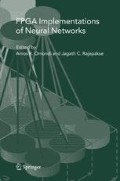Abstract
Associative networks have a number of properties, including a rapid, compute efficient best-match and intrinsic fault tolerance, that make them ideal for many applications. However, large networks can be slow to emulate because of their storage and bandwidth requirements. In this chapter we present a simple but effective model of association and then discuss a performance analysis we have done in implementing this model on a single high-end PC workstation, a PC cluster, and FPGA hardware.
Access this chapter
Tax calculation will be finalised at checkout
Purchases are for personal use only
Preview
Unable to display preview. Download preview PDF.
References
Amari S., 1997. The neural Theory of Association and Concept Formation, Biol. cyber. 26, pp. 175–185
Anderson J. A. and others, 1999. Radar Signal Categorization Using a Neural Network, Proceedings of the IEEE, 1990, August.
Anderson J. A., 1995. Introduction to Neural Networks, MIT Press, Cambridge, MA.
Batcher K. E., 1977. The Multi-dimensional access in STARAN, IEEE Transactions on Computers, Special Issue on Parallel Processing, pp. 174–177
Braitenberg V., 2001. Brain Size and Number of Neurons: An Exercise in Synthetic Neuroanatomy, Journal of Computational Neuroscience, 10, pp. 71–77
Braitenberg V. and A. Schuz, 1998. Cortex: Statistics and Geometry of Neuronal Connectivity, Springer-Verlag.
Buckingham J. T. and D. J. Willshaw, 1992. Performance characteristics of the associative net, Network, 3, pp. 407–414
Field D. J., 1999. What is the goal of sensory coding? Unsupervised Learning, MIT Press, pp. 101–143.
Gropp W., E. Lusk et al., 1999. Using MPI Portable Parallel Programming with the Message Passing Interface, MIT Press, Cambridge, MA.
Hebb D. O., 1999. The Organization of Behavior, Wiley, New York.
Hecht-Nielsen R. Tutorial: Cortronic Neural Networks, 1999, International Joint Conference on Neural Networks, Washington, DC.
Hopfield J., 1982. Neural networks and physical systems with emergent collective computational abilities, Proc. Natl. Acad. Sci. USA 79.
Kerr J. R. C. H. Luk et al., 2003. Advanced integrated enhanced vision systems, SPIE.
Kohonen T., 1984. Self-Organization and Associative Memory, SpringerVerlag, Heidelberg
Lansner A. and A. Holst, 1996. A Higher Order Bayesian Neural Network with Spiking Units, Int. J. Neural Systems, 7(2), pp. 115–128.
Lansner A. and others, 1997. Detailed Simulation of Large Scale Neural Networks. Computational Neuroscience: Trends in Research 1997, Plenum Press, J. M. Bower. Boston, MA, pp. 931–935.
Maass W. and C. M. Bishop, Pulsed Neural Networks, MIT Press, 1999, address=Cambridge MA
Omohundro S. M., 1990. Bumptrees for efficient function, constraint, and classification learning, Advances in Neural Information Processing Systems, 3, Denver, Colorado, Morgan Kauffmann.
O’Reilly R. and Y. Munakata, 2000. Computational Explorations in Cognitive Neuroscience-Understanding the Mind by Simulating the Brain, MIT Press., Cambridge, MA
Palm G., 1980. On Associative Memory, Biological Cybernetics, 36, pp. 19–31
Palm G. F. Schwenker et al., 1997. Neural Associative Memories. Associative Processing and Processors, IEEE Computer Society, pp. 284–306, Los Alamitos, CA.
Reschke C. T. Sterling et al. A Design Study of Alternative Network Topologies for the Beowulf Parallel Workstation, High Performance and Distributed Computing, 1996
Steinbuch K., 1967. Die Lernmatrix., Kybernetik, 1.
Willshaw D. and B. Graham, 1995. Improving Recall From An Associative Memory, Biological Cybernetics, 72, pp. 337–346.
Zhu S. and D. Hammerstrom, 2002. Simulation of Associative Neural Networks, ICONIP, Singapore.
Author information
Authors and Affiliations
Editor information
Editors and Affiliations
Rights and permissions
Copyright information
© 2006 Springer
About this chapter
Cite this chapter
Hammerstrom, D., Gao, C., Zhu, S., Butts, M. (2006). FPGA Implementation of Very Large Associative Memories. In: Omondi, A.R., Rajapakse, J.C. (eds) FPGA Implementations of Neural Networks. Springer, Boston, MA . https://doi.org/10.1007/0-387-28487-7_6
Download citation
DOI: https://doi.org/10.1007/0-387-28487-7_6
Publisher Name: Springer, Boston, MA
Print ISBN: 978-0-387-28485-9
Online ISBN: 978-0-387-28487-3
eBook Packages: EngineeringEngineering (R0)

